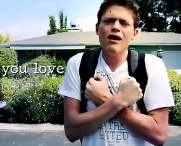References
Bahan, Ben. (2006). Face-to-face tradition in the American Deaf community. In H-Dirksen L. Bauman, Jennifer L. Nelson, & Heidi M. Rose (Eds.), Signing the body poetic: Essays on American Sign Language literature (pp. 21–50). Berkeley, CA: University of California Press.
Bauman, H-Dirksen L. (2003). Redesigning literature: The cinematic poetics of American Sign Language poetry. Sign Language Studies, 4(1), 34–47.
Bauman, H-Dirksen L. (2007). Open your eyes: Deaf Studies talking. Minneapolis, MN: University of Minnesota Press.
Bauman, H-Dirksen L., Nelson, Jennifer L., & Rose, Heidi M. (Eds.). (2006). Signing the body poetic: Essays on American Sign Language literature. Berkeley, CA: University of California Press.
Berdy, Sean. (2012, February 18). Enrique Iglesias’s Hero in American Sign Language [Sean Berdy] [Video file]. YouTube. Retrieved from http://www.youtube.com/watch?v=umFt33u5gFs
Brueggemann, Brenda Jo. (1999). Lend me your ear: Rhetorical constructions of deafness. Washington, DC: Gallaudet University Press.
Brueggemann, Brenda Jo. (2009). Deaf subjects: Between identities and places. New York, NY: New York University Press.
Ceraso, Steph. (2014). (Re)educating the senses: Multimodal listening, bodily learning, and the composition of sonic experiences. College English, 77(2), 102–123.
D-PAN (Deaf Professional Arts Network). (n.d.). About. D-PAN. Retrieved from http://d-pan.com/about/
D-PAN. (2008, March 28). D-PAN ASL music video: “Beautiful” by Christina Aguilera [Video file]. YouTube. Retrieved from http://www.youtube.com/watch?v=C6zVFGpGNJQ
D-PAN. (2013, October 28). D-PAN ASL music video: “Fireflies” by Owl City [Video file]. YouTube. Retrieved from http://www.youtube.com/watch?v=LC7iWXoVEOA
Dolmage, Jay. (2008a). Disability, usability, and universal design. In Shelley Rodrigo & Susan Miller (Eds.), Rhetorically re–thinking usability (pp. 167–190). Cresskill, NJ: Hampton.
Dolmage, Jay. (2008b). Mapping composition: Inviting disability in the front door. In Cynthia Lewiecki-Wilson & Brenda Jo Brueggemann (Eds.), Disability and the teaching of writing (pp. 14–27). Boston, MA: Bedford/St. Martin’s.
Fleckenstein, Kristie. (2003). Embodied literacies: Imageword and a process of teaching. Carbondale, IL: Southern Illinois University Press.
Forbes, Sean. (2010, May 11). Sean Forbes “I’m Deaf” [Video file]. YouTube. Retrieved from https://www.youtube.com/watch?v=E5l-2Jo14cQ
Forbes, Sean. (2011, May 31). Sean Forbes “Let’s mambo” ft. Marlee Matlin [Video file]. YouTube. Retrieved from http://www.youtube.com/watch?v=w2KYAlcTQno
Forbes, Sean. (2013, July 30). Sean Forbes “Watch these hands” OFFICIAL MUSIC VIDEO [Video file]. YouTube. Retrieved from https://www.youtube.com/watch?v=7lQx1f5lEFo
Foss, Sonja. (2004). Framing the study of visual rhetoric: Toward a transformation of rhetorical theory. In Charles A. Hill & Marguerite Helmers (Eds.), Defining visual rhetorics (pp. 303–313). Mahwah, NJ: Lawrence Elbaum Associates, Inc.
Halbritter, Bump. (2012). Mics, cameras, symbolic action: Audio-visual rhetoric for writing teachers. Anderson, SC: Parlor Press.
Hocks, Mary E. (2003). Understanding visual rhetoric in digital writing environments. College Composition and Communication, 54(4), 629–656.
Hull, Glynda A., & Nelson, Mark Evan. (2006). Locating the semiotic power of multimodality. Written Communication, 22(2), 224–261.
Jones, Jeannette Di Bernardo. (2015). Imagined hearing: Music-making in Deaf culture. In Blake Howe, Stephanie Jensen-Moulton, Neil Lerner, & Joseph Straus (Eds.), The Oxford handbook of music and disability studies (pp. 54–72). New York, NY: Oxford University Press.
Kerschbaum, Stephanie. (2013). Mode. In M. Remi Yergeau et al., Multimodality in motion: Disability and kairotic spaces. Kairos: A Journal of Rhetoric, Technology, Pedagogy, 18(1). Retrieved from http://kairos.technorhetoric.net/18.1/coverweb/yergeau-et-al/pages/mod/index.html
Kress, Gunther. (2005). Gains and losses: New forms of texts, knowledge, and learning. Computers and Composition, 22(1), 5–22.
Kress, Gunther, & van Leeuwen, Theo. (2001). Multimodal discourse: The modes and media of contemporary communication. New York, NY: Oxford University Press.
Lewiecki-Wilson, Cynthia, & Brueggemann, Brenda Jo (Eds.). (2008). Disability and the teaching of writing: A critical sourcebook. New York, NY: Bedford/St. Martin’s.
Mahon, Wade. (2010) Multimodal composition and the rhetoric of teaching: A conversation with Cheryl Ball. Issues in Writing, 18(2), 111–131.
Mitchell, W.J.T. (2006). Preface. In H-Dirksen L. Bauman, Jennifer L. Nelson, & Heidi M. Rose (Eds.), Signing the body poetic: Essays on American Sign Language literature (pp. xv–xxiii). Berkeley, CA: University of California Press.
New London Group. (1996). A pedagogy of multiliteracies: Designing social futures. Harvard Educational Review, 66(1), 60–92.
Oswal, Sushil K. (2013). Ableism. In M. Remi Yergeau et al., Multimodality in motion: Disability and kairotic spaces. Kairos: A Journal of Rhetoric, Technology, Pedagogy, 18(1). Retrieved from http://kairos.technorhetoric.net/18.1/coverweb/yergeau-et-al/pages/ableism/index.html
Selfe, Cynthia. (2009). The movement of air, the breath of meaning: Aurality and multimodal composing. College Composition and Communication, 60(4), 611–663.
Selfe, Cynthia & Howes, Franny. (2013). Over there: Disability studies and composition. In M. Remi Yergeau et al., Multimodality in motion: Disability and kairotic spaces. Kairos: A Journal of Rhetoric, Technology, Pedagogy, 18(1). Retrieved from http://kairos.technorhetoric.net/18.1/coverweb/yergeau-et-al/pages/index.html
Stokoe, William. (2006). Foreword. In In H-Dirksen L. Bauman, Jennifer L. Nelson, & Heidi M. Rose (Eds.), Signing the body poetic: Essays on American Sign Language literature (pp. xiii). Berkeley, CA: University of California Press.
Yamin, Fayez. (2012, June 4). Fayez Yamin “Hero” - FzY Studios (Enrique Iglesias cover) [Video file]. YouTube. Retrieved from https://www.youtube.com/watch?v=GylR9Ub16Gc
Yergeau, M. Remi. (2009, Spring). aut(hored)ism. Computers and Composition Online. Retrieved from http://www2.bgsu.edu/departments/english/cconline/dmac/
Yergeau, M. Remi. (2013). Reason. In M. Remi Yergeau et al., Multimodality in motion: Disability and kairotic spaces. Kairos: A Journal of Rhetoric, Technology, Pedagogy, 18(1). Retrieved from http://kairos.technorhetoric.net/18.1/coverweb/yergeau-et-al/pages/reason/index.html
Yergeau, M. Remi. (2014, Spring). Disability hacktivism. In Mary Hocks & Jentery Sayers (Eds.), Hacking the classroom: Eight perspectives. Computers and Composition Online. Retrieved from http://www2.bgsu.edu/departments/english/cconline/hacking/
Yergeau, M. Remi, et al. (2013). Multimodality in motion: Disability and kairotic spaces. Kairos: A Journal of Rhetoric, Technology, Pedagogy, 18(1). Retrieved from http://kairos.technorhetoric.net/18.1/coverweb/yergeau-et-al/index.html
Zdenek, Sean. (2009, Fall). Accessible podcasting: College students on the margins in the new media classroom. Computers and Composition Online, 1–21. Retrieved from http://www2.bgsu.edu/departments/english/cconline/Zdenek_Word_version_CConline.pdf
Zdenek, Sean. (2011). Which sounds are significant? Towards a rhetoric of closed captioning. Disability Studies Quarterly, 31(3). Retrieved from http://dsq-sds.org/article/view/1667/1604
I want to express my genuine gratitude to the Kairos reviewers whose critical feedback and invaluable suggestions have guided my revisions for this webtext and my mindset as I approach my research in general.
